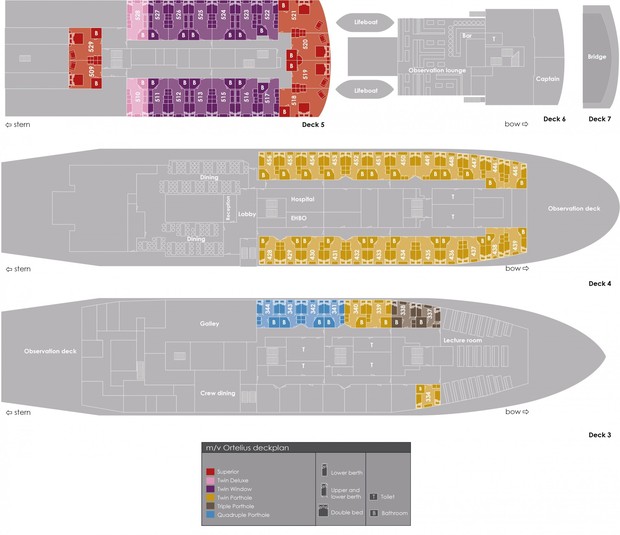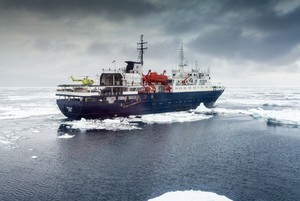
The east shores of Spitsbergen are a fantastic place to view gorgeously rugged landscapes and exotic Arctic wildlife, including minke whales, Arctic foxes, and polar bears. And speaking of bears, this exploratory cruise also visits Bear Island – a bird lover’s dream, where large colonies of Brünnich’s guillemots, kittiwakes, and fulmars breed on shoreline cliffs over spans of dazzling drift ice.
- Spectacular Hornsund
- Rarely visited Hopen Island
- Kittiwakes, canyons, and south Edgeøya
- Guillemot colony and south Spitsbergen
Prices quoted here are often dependent on currency fluctuations. Please check with (01432 507450 or info@small-cruise-ships.com) for the very latest price, which may well be cheaper than the one advertised here.
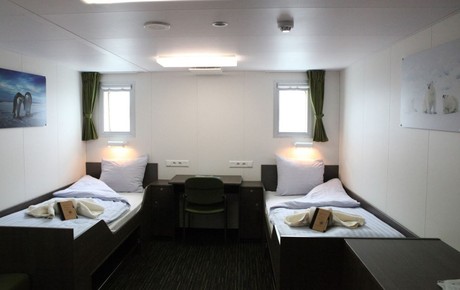
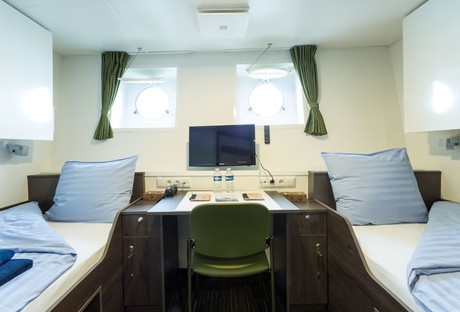


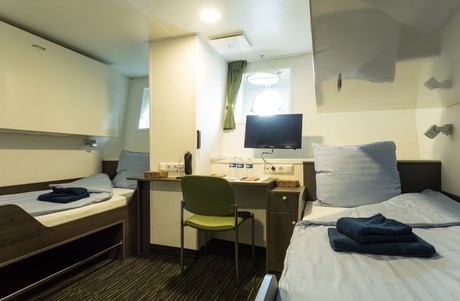

You touch down in Longyearbyen, the administrative center of Spitsbergen, the largest island of the Svalbard archipelago. Enjoy strolling around this former mining town, whose parish church and Svalbard Museum make for fascinating attractions. Though the countryside appears stark, more than a hundred species of plant have been recorded in it. In the early evening, the ship sails out of Isfjorden, where we might spot the first minke whale of the voyage.
We start the day by quietly cruising the side fjords of the spectacular Hornsund area in southern Spitsbergen, enjoying the scenery of towering mountain peaks. The mountain of Hornsundtind rises to 1,431 meters (4,695 feet), while the peak of Bautaen testifies to why early Dutch explorers gave this island the name Spitsbergen, meaning “pointed mountains.” There are 14 magnificent glaciers in the area, and we have a fair chance of encountering seals and polar bears. The nearby cliffs of Sofiakammen are also home to thousands of pairs of nesting kittiwakes and little auks, and in the evening, we might see thousands of harp seals rutting on ice floes at Sørkapp.
We arrive at the southeastern end of Bear Island, a great place for viewing large seabird colonies. The nearby nesting cliffs are part of an extensive nature reserve where large ships are not allowed to bring passengers on shore. Afterward we’ll sail northeast into Sorhamna, where we can get closer to the seabird cliffs. Chiefly Brünnichs guillemots, kittiwakes, and fulmars nest here.
Just north of this, in Kvalrossbukta, we will land and see the remains of a whaling station from early in the previous century. We might also make a landing in a shallow valley, such as Rendalen, and look for (at a safe distance) great skuas, large seabirds known to be fiercely territorial. As we continue north along the east side of Bear Island, we may still encounter dazzling shoals of drift ice.
On the way to Hopen, we may encounter sea ice with rutting harp seals. We land at the southern end of Hopen Island, at Koefoetodden, where you can see the remains of 17th-century whaling sites. Through nearby Bekkeskaret is an easy route to Kvasstoppen (190 meters, 620 feet) and the remains of a plane from World War II. Hopen Radio station is the most remote manned weather station in all of Svalbard.
We may still encounter heavy sea ice in the Barentsz Current, where we have a good chance of spotting polar bears as well as various species of seal and seabird.
Sailing along the western side of the Tusenöyane (where we’re not allowed to land in summer), we may see polar bears and walruses as we approach Risetreppen. This beautiful canyon features an accessible kittiwake colony, and during our walk we may encounter reindeer on the lush tundra.
Today we go to shore at Ardalstangen, a ruggedly scenic area with lakes and different species of waterfowl. Later in nearby Habenichtbukta, we can look from some distance to a wintering site of 18th-century Pomor trappers, who often stayed for years in the same place. Later in the afternoon, we aim to land at the south side of Russebukta, near a tundra with reindeer and great walking opportunities.
Our goal for the first part of the day is a landing at the mountain of Stellingfjellet, near the largest colony of Brünnich’s guillemots in Spitsbergen. Later on we will make landings at the rarely visited coast of south Spitsbergen, at the bay of Isbukta.
We continue our voyage in Bell Sund, one of the largest fjord systems in Svalbard. The ocean currents make this area slightly warmer than other areas in Spitsbergen.
Even the greatest journeys must eventually come to an end. We disembark today in Longyearbyen, taking home memories that will accompany us wherever the next adventure lies.
All itineraries are for guidance only. Programs may vary depending on ice, weather, and wildlife conditions. Landings are subject to site availabilities, permissions, and environmental concerns per AECO regulations. Official sailing plans and landing slots are scheduled with AECO prior to the start of the season, but the expedition leader determines the final plan. Flexibility is paramount for expedition cruises. The average cruising speed of our vessel is 10.5 knots.
Ortelius

| Length | 91 metres |
|---|
The ice-strengthened vessel “Ortelius” is an excellent vessel for Polar expedition cruises in the Arctic and Antarctica, providing possibilities to adventure remote locations such as the Ross Sea.
The vessel has the highest ice-class notation (UL1 equivalent to 1A) and is therefore very suitable to navigate in solid one-year sea ice and loose multi-year pack ice. “Ortelius” is a great expedition vessel for 100 passengers with lots of open-deck spaces and a very large bridge which is accessible to the passengers. The vessel is manned by 34 highly experienced crew, 15 international catering staff, including stewardesses, 6 expedition staff (1 expedition leader and 5 guides/lecturers) and 1 doctor.
”Ortelius” offers a comfortable hotel standard, with two restaurants, a bar/lecture room and a sauna. Ortelius' voyages are primarily developed to offer our passengers a quality exploratory wildlife program, trying to spend as much time ashore as possible. As the number of passengers is limited to approximately 100 on the “Ortelius”, flexibility assures maximum wildlife opportunities.
Passengers on a typical voyage range from in their 30s to their 80s, with the majority usually between 45 ― 65. Our expeditions attract independent travelers from around the globe who are characterized by a strong interest in exploring remote regions. The camaraderie that develops on board is an important part of the Oceanwide experience, and many passenger groups include several nationalities.
“Ortelius” was built in Gdynia, Poland in 1989, was named “Marina Svetaeva”, and served as a special purpose vessel for the Russian Academy of Science. The vessel is re-flagged and renamed “Ortelius”. Ortelius was a Dutch / Flemish cartographer. Abraham Ortelius (1527 – 1598) published the first modern world atlas, the Theatrum Orbis Terrarum or Theatre of the World in 1570. At that time, the atlas was the most expensive book ever printed.
What to Wear
In keeping with the spirit of expedition, dress on board is informal. Bring casual and comfortable clothing for all activities, and keep in mind that much of the scenery can be appreciated from deck ― which can be slippery. Bring sturdy shoes with no-slip soles, and make sure your parka is never far away in case one of our crew shouts “Whales!” over the loudspeaker and you have to dash outside in a moment’s notice. Opt for layers, as it is comfortably warm aboard the ship though often cold on deck.
Electric Current
The electrical supply aboard ship is 220v, 60Hz. Electrical outlets are standard European with two thick round pins, so some passengers may need a 220v/110v converter.
Tipping
The customary gratuity to the ship’s service personnel is made as a blanket contribution at the end of the voyage and is divided among the crew. Tipping is a personal matter, and the amount you wish to give is at your sole discretion. As a generally accepted guideline, we suggest 8 ― 10 euros per passenger per day. It is better for the crew if you give cash.
Smoking Policy
Ortelius has a non-smoking policy inside, though you can smoke in certain designated areas. We ask that you please respect the wishes of non-smokers and please never throw your cigarette ends overboard or anywhere except the designated bin.
